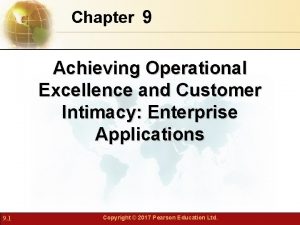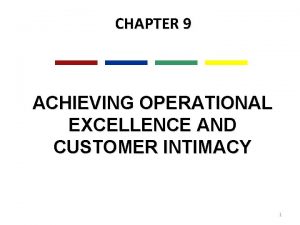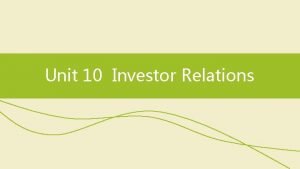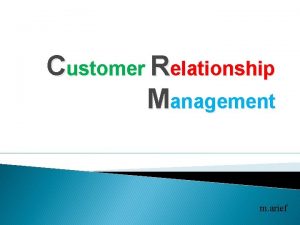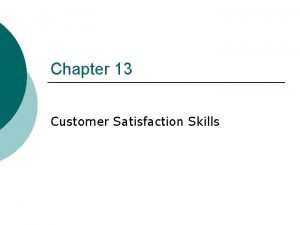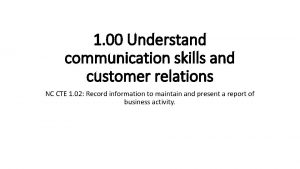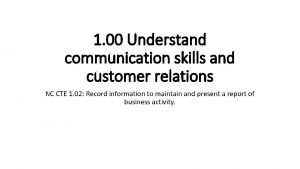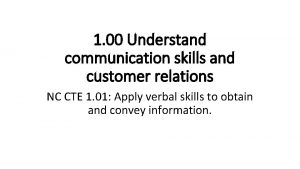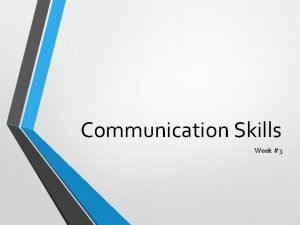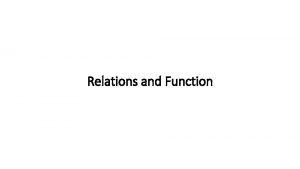1 00 Understand communication skills and customer relations












- Slides: 12

1. 00 Understand communication skills and customer relations NC CTE 1. 02: Record information to maintain and present a report of business activity.

Utilize note-taking strategies • Note-taking strategies • Cornell two-column note-taking • Draw a line down your paper 2 1/2 inches from the left side to create a 2 1/2 inch margin for noting key words and a 6 -inch area on the right for sentence summaries. • Record your notes in the 6 -inch area on the right side of your paper during class. Use your own words and make sure you have included the main ideas and significant supporting details. Be brief. • Review your summary sentences and underline key words. Write these key words in the column on the left side of your paper. These words can be used to stimulate your memory of the material for later study. • The Cornell method can be used for taking notes on classroom lectures or textbooks.

Utilize note-taking strategies • Note-taking strategies • Charting • If the lecture format is distinct (such as chronological), you may set up your paper by drawing columns and labeling appropriate headings in a table. • Determine the categories to be covered in the lecture. Set up your paper in advance by columns headed by these categories. As you listen to the lecture, record information (words, phrases, main ideas, etc. ) into the appropriate category.

Utilize note-taking strategies • Note-taking strategies • Outlining • Start main points at the margin. • Indent secondary and supporting details. • Further indent major subgroups. • Definitions, for example, should always start at the margin. • When a list of terms is presented, the heading should also start at the margin. • Each item in the series should be set in slightly from the margin. • Examples, too, should be indented under the point they illustrate. • When the lecturer moves from one idea to another, show this shift with white space by skipping a line or two.

Utilize note-taking strategies • Note-taking strategies • Mapping is a visual system of condensing material to show relationships and importance. A map is a diagram of the major points, with their significant sub-points, that support a topic. The purpose of mapping as an organizing strategy is to improve memory by grouping material in a highly visual way. • The map provides a quick reference for over-viewing a lecture or a textbook chapter. • How to Map • Draw a circle or a box in the middle of a page, and in it write the subject or topic of the material or lecture. • Determine the main ideas that support the subject and write them on the lines radiating from the central circle or box. • Determine the significant details and write them on lines attached to each main idea. The number of details you include will depend on the material and your purpose.

Utilize note-taking strategies Common note-taking abbreviations Do not try to perfect a definite system of “shorthand. ” You may select one or any combination of those ideas that fit your needs. • Symbols are especially helpful to students in engineering and mathematics. ≠ does not equal Δ change f frequency dept = department NYC = New York City • Use only the first syllable of a word. pol = politics dem = democracy lib = liberal cap = capitalism • Use the entire first syllable and only the first letter of the second syllable. subj = subject cons = conservative tot = totalitarianism ind = individual • Use symbols for commonly recurring connective or transitional words. & = and w/= with w/o= without vs= against • Eliminate final letters. Use just enough of the beginning of a word to form easily recognizable unit. assoc= associate, associated ach = achievement biol = biological info = information intro = introduction chem = chemistry con = concentration max = maximum rep = repetition • Omit vowels from the middle of words, and retain only enough constants to provide a recognizable skeleton of the word. bkgd = background ppd = prepared prblm = problem estmt = estimate gvt = government • Use an apostrophe. gov’t = government am’t = amount con’t = continued educat’l = educational

Organize information • Discuss reasons to organize information after taking notes. • Clear up points of confusion by talking with the instructor and/or classmates. If you don't have time after class, use email or raise the issue during the next class. • Use texts, online documents, and Internet searches to fill in missing points, find specific examples of themes or processes, and to clarify doubts. • Edit and expand notes as soon as possible. Mark what you consider big concepts. • Jot down in margins the notes of your own reflections, ideas, and questions. • Do assignments while the material is still fresh.

Organize information • Explain the impact that target audience has on the organization of information. • In the world of business, methods of organization can be used to convey an idea, relay information, assemble a procedure and seal a deal. • Methods of organization create order and direct the thoughts of the audience interacting with the information. • Whether it is creating a report, sorting data, presenting an idea or organizing facts, choosing a method of organization sets the stage for decision-making.

Organize information • Common approaches to organizing/ordering information Method of Organizing Information Indexed order e. g. , Alphabetical Description Example Items of a sequence can be arranged by some familiar characteristic. The most common is alphabetical. Alphabetical is a logical way to arrange a booklet on vitamins (A, B, B 1, and so on) or a directory of company employees. Chronological order A method of organization in which actions or events You can present events in the order in which they are presented as they occur (or occurred) in time. happened. History books are written this way. Information presented in time sequence, either forward or backward, is chronological Inverted pyramid (aka anticlimactic order) The lead paragraph summarizes the story, and the following paragraphs present the facts in order of decreasing importance. Climatic order (aka clincher order) The arrangement of details or ideas in order of increasing importance or force: the principle of saving the best for last. Spatial/Geographical Order of location A method of organization in which details are presented as they are (or were) located in space-such as, from left to right or from top to bottom. You can use this format in journal articles, letters, memos, and reports. Useful for ranking items (such as candidates, where the best are placed first). It is frequently used in a sales pitch or for increasing motivation gradually. Designed to impel immediate action or leave a sweet taste in the reader’s mouth. Geographical organization is illustrated by the division of a business into sales by state, county, or city.

Organize information Method of Organizing Information Simple to Complex Description Order of increasing difficulty (aka progressive level of disclosure) Inductive (indirect) This plan supplies examples, stories, facts, or reasons first and then draws conclusions from them. Deductive (direct) Start with a generalization, and then support it with facts, research results, examples, and illustrations. Sequential Process or instruction generally follow a linear or sequential movement Problem/solution The problem/solution format begins with “Here’s what the problem was” and ends with “Here’s how we solved it. ” Example For difficult, technical, or abstract topics, the best plan of organization is often from simple to complex. Good teachers, for example, begin with simple, basic concepts and proceed to more complex topics. For example, a report written to convince management to fund an employee fitness program might begin with the advantages of a fitness program. After describing the benefits, draw the conclusion that a company-sponsored fitness program is a wise investment. Scientists use this format in research papers that begin with the findings or main conclusions and then state the supporting evidence. Some technical activities, such as the installation of equipment, must be done in a certain order, and the presentation of instructions must follow that order. (Proposal) papers identify a problem, usually weigh alternative, and suggest a solution. They may also suggest ways to implement and evaluate the proposed plan.

Organize information Method of Organizing Information Description Example Classification groups objects or people into related categories the good student, the struggling student, the laid back student Cause & Effect Address a single cause that has many effects or with many causes that produce a single effect. Comparison and Contrast Comparing the advantages and disadvantages of A rhetorical strategy and method of organization products such as Andriod and Apple. in which a writer examines similarities and/or differences between two people, places, ideas, or things Value/Size Realtors listing their properties from the most The logical order for some topics begins with the expensive to the least expensive (or vice-versa) is most valuable or the largest item first. helpful to buyers and sellers Paper on Renewable Energy and Non-Renewable of Energy

Select and use appropriate graphic aids • A table shows relationships between facts and figures by arranging information in rows and Columns (Examples were slides 9 -11). • Bar graphs should be used when showing quantities that are either not necessarily linked or demonstrate change over time. For example, use a bar graph to show either company revenue totals over the past decade or raw sales figures for different departments. • Line graphs are used to track changes over short and long periods of time. When smaller changes exist, line graphs are better to use than bar graphs. Line graphs can also be used to compare changes over the same period of time for more than one group. • Pie charts should be used when the data shows how different categories relate to the whole at a particular point in time, such as either company expense categories or percentages of city statistics particular year. • Pictures and photographs are visual materials, used to stimulate a learner’s interest. Properly selected and adapted they can help readers to understand remember the content of accompanying verbal materials.
 To understand recursion you must understand recursion
To understand recursion you must understand recursion Employee relations in public relations
Employee relations in public relations Customer relationship management and customer intimacy
Customer relationship management and customer intimacy Customer relationship management and customer intimacy
Customer relationship management and customer intimacy Intimacy
Intimacy And then sentence
And then sentence Marketing information and customer insights are
Marketing information and customer insights are Pengertian customer relation
Pengertian customer relation Beyond customer satisfaction to customer loyalty
Beyond customer satisfaction to customer loyalty Intrapersonal relationship skills
Intrapersonal relationship skills Teachable abilities or skill sets that are easy quantify.
Teachable abilities or skill sets that are easy quantify. Customer satisfaction skills
Customer satisfaction skills Customer service skills in hospitality
Customer service skills in hospitality



